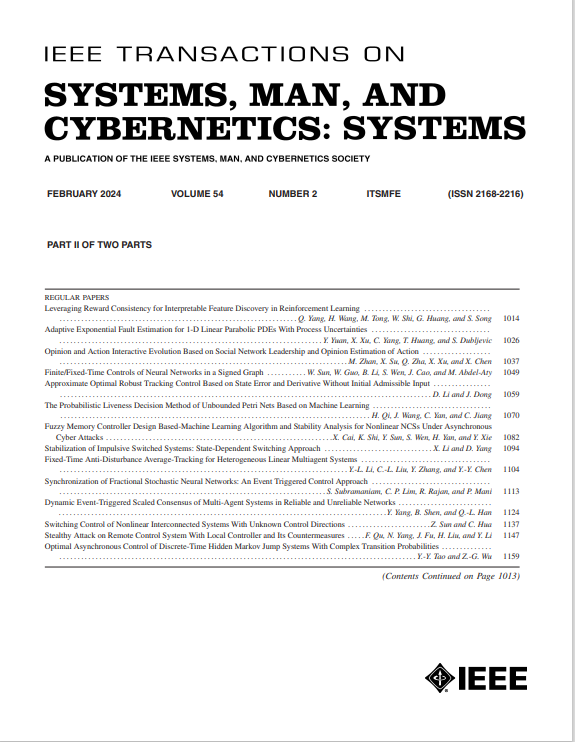基于状态观测的人-无人机群分布式协同控制
IF 8.7
1区 计算机科学
Q1 AUTOMATION & CONTROL SYSTEMS
IEEE Transactions on Systems Man Cybernetics-Systems
Pub Date : 2025-07-22
DOI:10.1109/TSMC.2025.3584209
引用次数: 0
摘要
本文提出了一种无人机协同控制的集成框架,将先进的分布式控制策略与人群交互机制相结合,以解决避障场景。首先,分布式控制器被设计为显式地考虑观察者的错误。具体而言,提出了一阶和高阶控制屏障函数,并结合有界误差观测器进行了理论验证。这些cbf对控制输入施加约束,以保证整个操作过程中的系统安全。其次,引入了三层人-无人机群交互架构,实现了跨不同操作层次的综合人工干预。为了验证该方法的有效性和实用性,在目标跟踪救援场景下进行了仿真实验。与传统方法相比,集成的观察者-控制器设计表现出优越的性能,表现出增强的避障能力和鲁棒抗干扰能力。该三层框架能有效协调人-无人机群体交互,提高群体任务效率。本文章由计算机程序翻译,如有差异,请以英文原文为准。
Distributed Cooperative Control of Human–UAV Swarm Based on State Observation
This article proposes an integrated framework for unmanned aerial vehicles (UAVs) cooperative control, combining advanced distributed control strategies with human–swarm interaction mechanisms to address obstacle avoidance scenarios. First, distributed controllers are designed to explicitly account for observer errors. Specifically, first-order and high-order control barrier functions (CBFs), integrated with the bounded-error observer, are proposed and theoretically validated. These CBFs impose constraints on the control inputs to guarantee system safety during the entire operation. Second, a three-tier human–UAV swarm interaction architecture is introduced, enabling comprehensive human intervention across different operational levels. To verify the effectiveness and practicality of the proposed method, simulation experiments are conducted in a target tracking and rescue scenario. The integrated observer–controller design demonstrates superior performance over conventional approaches, exhibiting enhanced obstacle avoidance capabilities and robust disturbance rejection. The three-tier framework can effectively coordinate human–UAV swarm interaction and improve the efficiency of the swarm mission.
求助全文
通过发布文献求助,成功后即可免费获取论文全文。
去求助
来源期刊

IEEE Transactions on Systems Man Cybernetics-Systems
AUTOMATION & CONTROL SYSTEMS-COMPUTER SCIENCE, CYBERNETICS
CiteScore
18.50
自引率
11.50%
发文量
812
审稿时长
6 months
期刊介绍:
The IEEE Transactions on Systems, Man, and Cybernetics: Systems encompasses the fields of systems engineering, covering issue formulation, analysis, and modeling throughout the systems engineering lifecycle phases. It addresses decision-making, issue interpretation, systems management, processes, and various methods such as optimization, modeling, and simulation in the development and deployment of large systems.
 求助内容:
求助内容: 应助结果提醒方式:
应助结果提醒方式:


